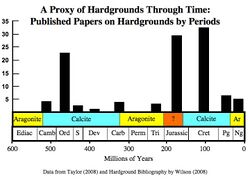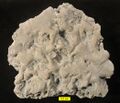Earth:Carbonate hardgrounds
Carbonate hardgrounds are surfaces of synsedimentarily cemented carbonate layers that have been exposed on the seafloor (Wilson and Palmer, 1992). A hardground is essentially, then, a lithified seafloor. Ancient hardgrounds are found in limestone sequences and distinguished from later-lithified sediments by evidence of exposure to normal marine waters. This evidence can consist of encrusting marine organisms (especially bryozoans, oysters, barnacles, cornulitids, hederelloids, microconchids and crinoids), borings of organisms produced through bioerosion, early marine calcite cements, or extensive surfaces mineralized by iron oxides or calcium phosphates (Palmer, 1982; Bodenbender et al., 1989; Vinn and Wilson, 2010; Vinn and Toom, 2015). Modern hardgrounds are usually detected by sounding in shallow water or through remote sensing techniques like side-scan sonar.

Carbonate hardgrounds often host a unique fauna and flora adapted to the hard surface. Organisms usually cement themselves to the substrate and live as sessile filter-feeders (Brett and Liddell, 1982). Some bore into the cemented carbonate to make protective domiciles (borings) for filter-feeding. Sometimes hardgrounds are undermined by currents which remove the soft sediment below them, producing shallow cavities and caves which host a cryptic fauna (Palmer and Fürsich, 1974). The evolution of hardground faunas can be traced through the Phanerozoic, from the Cambrian Period to today (Taylor and Wilson, 2003).

Carbonate hardgrounds were most commonly formed during calcite sea intervals in Earth history, which were times of rapid precipitation of low-magnesium calcite and the dissolution of skeletal aragonite (Palmer and Wilson, 2004). The Ordovician-Silurian and the Jurassic-Cretaceous Systems have the most hardgrounds (sometimes hundreds in a single section) and the Permian-Triassic Systems have the least (usually none). This cyclicity in hardground formation is reflected in the evolution of hardground-dwelling communities. There are distinct differences between the Paleozoic and Mesozoic hardground communities: the former are dominated by thick calcitic bryozoans and echinoderms, the latter by oysters, deep bivalve (Gastrochaenolites) and sponge (Entobia) borings (Taylor and Wilson, 2003).
Stratigraphers and sedimentologists often use hardgrounds as marker horizons and as indicators of sedimentary hiatuses and flooding events (Fürsich et al., 1981, 1992; Pope and Read, 1997). Hardgrounds and their faunas can also represent very specific depositional environments such as tidal channels (Wilson et al., 2005) and shallow marine carbonate ramps (Palmer and Palmer, 1977; Malpas et al., 2004)
Cross-section of an Upper Ordovician hardground from Kentucky. The light-colored vertical elements are borings (Trypanites) filled with dolomite. The scale bar is 1.0 cm.
A Middle Ordovician hardground from the Kanosh Formation of Utah with echinoderm holdfasts cemented to its upper surface. The scale bar is 1.0 cm.
Petroxestes borings in an Upper Ordovician hardground, southern Ohio.
Trypanites borings in an Upper Ordovician hardground, Indiana .
Carbonate hardground with an encrusting bryozoan; Kanosh Formation (Middle Ordovician) of Utah; scale in mm.
Cross-section of a carbonate hardground encrusted by oysters and bored by bivalves (Gastrochaenolites); Carmel Formation (Middle Jurassic) of southern Utah.
References
- Bodenbender, B.E.; Wilson, M.A.; Palmer, T.J. (1989). "Paleoecology of Sphenothallus on an Upper Ordovician hardground". Lethaia 22 (2): 217–225. doi:10.1111/j.1502-3931.1989.tb01685.x.
- Brett, C.E.; Liddell, W.D. (1981). "Preservation and paleoecology of a Middle Ordovician hardground community". Paleobiology 4 (3): 329–348. doi:10.1017/s0094837300006035.
- Fürsich F.T., Kennedy, W.J., Palmer, T.J. (1981). "Trace fossils at a regional discontinuity surface: the Austin/Taylor (Upper Cretaceous) contact in central Texas". Journal of Paleontology 55: 537–551.
- Fürsich, F.T.; Oschmann, W.; Singh, B.; Jaitly, A.K. (1992). "Hardgrounds, reworked concretion levels and condensed horizons in the Jurassic of western India: their significance for basin analysis". Journal of the Geological Society of London 149 (3): 313–331. doi:10.1144/gsjgs.149.3.0313. Bibcode: 1992JGSoc.149..313F.
- Malpas, J.A.; Gawthorpe, R. L.; Pollard, J.E.; Sharp, I.R. (2004). "Ichnofabric analysis of the shallow marine Nukhul Formation (Miocene), Suez Rift, Egypt: implications for depositional processes and sequence stratigraphic evolution". Palaeogeography, Palaeoclimatology, Palaeoecology 215 (3–4): 239–264. doi:10.1016/j.palaeo.2004.09.007.
- Palmer, T.J. Fürsich, F.T. (1974). "The ecology of a Middle Jurassic hardground and crevice fauna". Palaeontology 17: 507–524.
- Palmer, T.J.; Palmer, C.D. (1977). "Faunal distribution and colonization strategy in a Middle Ordovician hardground community". Lethaia 10 (3): 179–199. doi:10.1111/j.1502-3931.1977.tb00608.x.
- Palmer, T.J.; Wilson, M.A. (2004). "Calcite precipitation and dissolution of biogenic aragonite in shallow Ordovician calcite seas". Lethaia 37 (4): 417–427. doi:10.1080/00241160410002135. Bibcode: 2004Letha..37..417P.
- Palmer, T.J. (1978). "Burrows at certain omission surfaces in the Middle Ordovician of the Upper Mississippi Valley". Journal of Paleontology 52: 109–117.
- Palmer, T.J. (1982). "Cambrian to Cretaceous changes in hardground communities". Lethaia 15 (4): 309–323. doi:10.1111/j.1502-3931.1982.tb01696.x.
- Pope, M.C.; Read, J.F. (1997). "High-resolution surface and subsurface sequence stratigraphy of the Middle to Late Ordovician (late Mohawkian-Cincinnatian) foreland basin rocks, Kentucky and Virginia". AAPG Bulletin 81: 1866–1893. doi:10.1306/3b05c654-172a-11d7-8645000102c1865d.
- Taylor, P.D.; Wilson, M.A. (2003). "Palaeoecology and evolution of marine hard substrate communities". Earth-Science Reviews 62 (1–2): 1–103. doi:10.1016/S0012-8252(02)00131-9. Bibcode: 2003ESRv...62....1T. http://doc.rero.ch/record/13828/files/PAL_E727.pdf.
- Vinn, O.; Wilson, M.A. (2010). "Microconchid-dominated hardground association from the late Pridoli (Silurian) of Saaremaa, Estonia". Palaeontologia Electronica 2010 (2): 13.2.9A. http://palaeo-electronica.org/2010_2/212/index.html. Retrieved 2012-09-16.
- Vinn, O.; Toom, U. (2015). "Some encrusted hardgrounds from the Ordovician of Estonia (Baltica)". Carnets de Géologie 15 (7): 63–70. doi:10.4267/2042/56744.
- Wilson, M.A.; Palmer, T.J. (1992). "Hardgrounds and hardground faunas". University of Wales, Aberystwyth, Institute of Earth Studies Publications 9: 1–131.
- Wilson, M.A.; Wolfe, K.R.; Avni, Y. (2005). "Development of a Jurassic rocky shore complex (Zohar Formation, Makhtesh Qatan, southern Israel)". Israel Journal of Earth Sciences 54 (3): 171–178. doi:10.1560/71EQ-CNDF-K3MQ-XYTA. http://doc.rero.ch/record/13762/files/PAL_E620.pdf.
Further reading
- Vinn, O. (2015). "Sparsely encrusted hardground in the Darriwilian calcareous sandstone of Cape Pakri, NW Estonia (Baltica)". Estonian Journal of Earth Sciences 64: 249–253. doi:10.3176/earth.2015.31. http://www.kirj.ee/public/Estonian_Journal_of_Earth_Sciences/2015/issue_3/earth-2015-3-249-253.pdf. Retrieved 2015-09-23.
- Vinn, O.; Wilson, M.A. (2010). "Early large borings from a hardground of Floian-Dapingian age (Early and Middle Ordovician) in northeastern Estonia (Baltica)". Carnets de Géologie 2010: CG2010_L04. doi:10.4267/2042/35594.
- Vinn, O.; Wilson, M.A.; Toom, U. (2015). "Bioerosion of Inorganic Hard Substrates in the Ordovician of Estonia (Baltica)". PLOS ONE 10 (7): e0134279. doi:10.1371/journal.pone.0134279. PMID 26218582. Bibcode: 2015PLoSO..1034279V.
- Vinn, O.; Toom, U. (2016). "A sparsely encrusted hardground with abundant Trypanites borings from the Llandovery of the Velise River, western Estonia (Baltica)". Estonian Journal of Earth Sciences 65: 19–26. doi:10.3176/earth.2016.01. http://www.kirj.ee/public/Estonian_Journal_of_Earth_Sciences/2016/issue_1/earth-2016-1-19-26.pdf. Retrieved 2016-03-05.
 |












